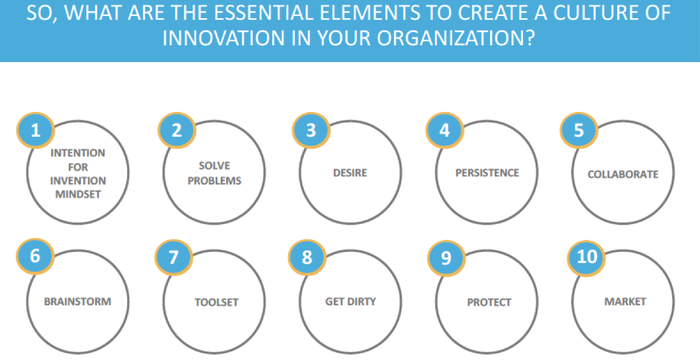Pool and spa professionals need to have a step-by-step process and a good understanding of the patent process.

Our industry is filled with talented, creative, hard-working, hands-on professionals that have many brilliant ideas. Product ideas can come from service techs, builders, retailers and even factory workers at manufacturing companies.
But because pool professionals don’t always have a clear process to innovative growth in their businesses or know how to patent, protect and monetize their ideas, many of them never make it to market or get gobbled up by bigger players.
To get started, professionals need to have a step-by-step process and a good understanding of the patent process. Having proven steps to follow, paired with education on the patent process, will help inventors get their ideas to market.
Proven 10-step Invention Process
To help provide a structure to the process of bringing pools to market, Thursday Pools created a 10-step process to guide its team to a successful product launch. Our goal is to share these steps to give a structure for success to inventors.
Step 1: Intent to Invent Mindset—You must be actively thinking and looking for something to invent. Once you have the idea, get excited and get ready to start a structured approach to getting the product to market. If the product or service is what customers want and desire, combined with patent protection, it can make people and companies millions of dollars. This is the beginning of a possible journey that can take months or even years. Searching for instant gratification or a get-rich-quick scheme is the enemy of realizing the dream of bringing your product to market.
Step 2: Solve Problems—Finding something that will solve a problem is what customers are looking to purchase, so be sure that the invention being pursued is something that solves a problem or makes life easier for builders, retailers, service professionals or consumers.
Step 3: Desire—You need a burning desire to make it happen. There will be many roadblocks as you seek to bring your product to market. So be sure you are passionate about your invention and have a deep desire to see it brought to market—you will need this to keep going and to get through challenging times.
Step 4: Persistence—Don’t give up when refining your product or service. Going back to the drawing board multiple times is common and most likely necessary. As you spend time examining the product and the market, you will likely find ways to improve on your idea and you might even happen upon a new and better idea along the way!
Step 5: Collaborate—This step is needed whether you are working in a company or alone. You will need help getting the product or service to market. Just make sure you have a non-disclosure agreement (NDA) in place if working with others outside your company. This applies to designers, suppliers, makers of prototypes, machinery and even market research firms.
Step 6: Brainstorming—This is a good technique to continue refining the product or service if you hit a roadblock. Keep re-imagining how the product or service will be used in the real world. Think of additional features that will enhance your original idea.
Step 7: Toolset—Having the right tools, equipment and software to bring the product to life is important. If you don’t, you may need to find a company that can build it or develops it for you. But remember to get those NDA agreements signed before sharing information. Better to be safe than sorry!
Step 8: Get dirty—From building the product and testing it out—this entire process of test marketing takes a lot of time and effort. You will need to roll up your sleeves to prove it out before you can be confident it works. Testing and validating your assumptions are key to ensuring success. Make sure you are in the field with potential users/buyers to receive feedback. Don’t be afraid to make adjustments in design. You don’t want to try to make adjustments after the product has been launched. A tested and proven product will be much easier to sell. And you don’t want to patent something that can be easily improved upon after the product has been launched.
Step 9: Protect—If you have a winning product, make sure you start down the patent process before you go to market. Beware of unethical invention companies. You can do this without their “help.” Be sure to get recommendations from trusted patent lawyers who are experts in our industry. Millions can be made either through producing the product or service, selling the rights outright or licensing agreements. Making the right choice is critical but having patent protection is the only way to ensure you have the strength of the government on your side. This is a powerful negotiating tool if selling the rights or licensing.
Understand the basics of the patent process. Pool professionals need to get a handle on what it means to get a patent on an idea or product. A patent gives its owner the right to exclude others from making, using and selling the claimed invention in the country that issued the patent. To get a patent, the claimed invention must be useful, novel and non-obvious. It is incumbent upon an inventor to file his patent application sooner rather than later. The first to file rule dictates that when two inventors have very similar inventions, it is the first one to file that gets priority over the other. However, the first to file rule only applies to true inventors—copiers cannot be awarded valid patents.
Patents promote innovation by granting a government-enforced limited monopoly to the inventor. Patent rights last for 20 years from the date of the filing of the patent application. In exchange, the public gets the right to practice the patented invention once the patent expires.
Step 10: Market—Getting your idea to market by selling the rights, licensing or producing is the “last mile” of the journey. Choosing which way to go can be exciting but financial intelligence is important. Multiple additional factors come into play so there is no formula to decide. Lifestyle, competencies, financial backing, competitive environment, economy all play factors in making the right decision. Many people struggle to understand the next steps and the ‘marketing sharks’ will begin to circle. Oftentimes the lack of funding can be a concern but can be overcome with good guidance.
Avoiding pitfalls of invention marketing scams: Once again, the sharks or unethical invention companies are out there looking for prey. Having honest, ethical and local legal help may be the best way to move your idea forward. Beware of people or companies who want to “help” you get your idea to market. It could end up costing you thousands of dollars and you may end up with nothing to show for the expense, other than frustration and a hole in your pocket.
We have all heard the success stories of those who have had an "aha" moment and turned their idea into millions of dollars. The media has done a great job hyping up those stories. Unfortunately, many people are unaware of all the steps needed and the years of hard work that it may require to make it big. It has been said, “Where there is a will there is a way.” Much depends on how much desire you have burning in your gut. Being systematic in your approach to an inventive idea will give you the structure needed to determine the best approach to bringing the product to market.

Ed Vondell is COO of Thursday Pools, LLC, a company that has designed, developed and manufactured fiberglass swimming pools for the last 10 years. Over the past decade, Thursday Pools has designed some unique swimming pools, add-on features and products that the end customer or installer desires. Some of the designs and products have patent protection so it gives the company a durable competitive advantage, which translates into increased revenue. A strong company provides security for the employees, their families, and the community.
About the Author(s)
You May Also Like




